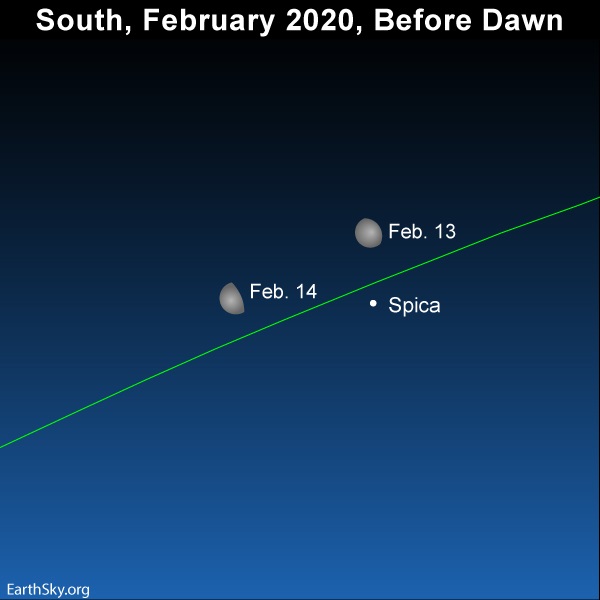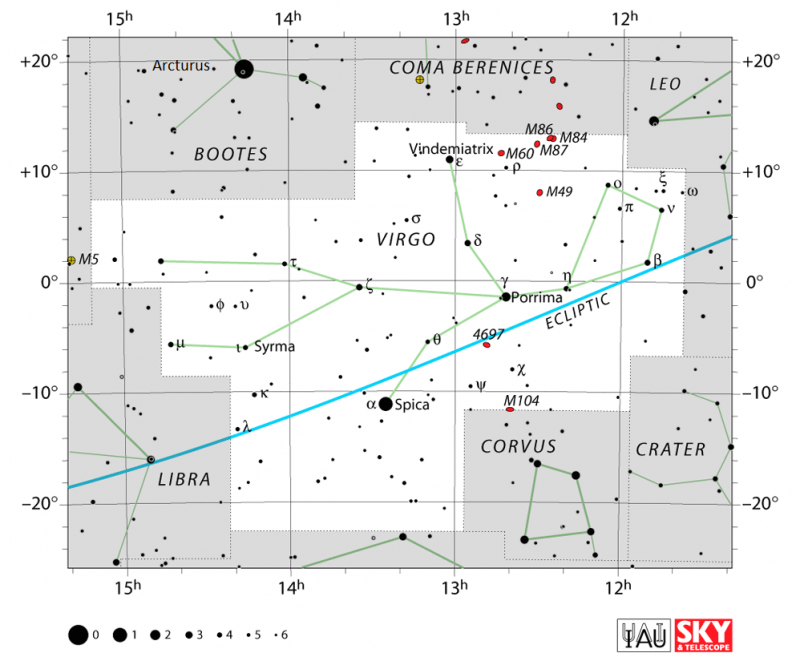On February 12, 2020, you’ll have to stay up late to view the moon and Spica, the constellation Virgo’s brightest star, rising into your eastern sky. At mid-northern latitudes, look for the twosome to be up by around 11 p.m. to 12 midnight. At more southerly latitudes, the moon and Spica rise earlier in the evening.
If you’re not one to stay up late, you can always wake up before sunrise February 13 to see the moon and Spica higher up in the predawn/dawn sky.

Want to know when the moon rises in your sky? Visit Sunrise Sunset Calendars and check the moonrise and moonset box.
Spica serves as a prime example of a 1st-magnitude star; in other words, it’s one of the brightest stars in our sky. You should have little trouble picking it out, even in the glare of the waning gibbous moon, over these next few nights.
Keep watching, and try to recognize patterns of stars around Spica if you can. If you do, once the moon leaves the evening sky in another few days, you’ll easily note Spica’s color. It is a blue-white gem of a star, and, for stars, color reveals temperature. Spica’s blue-white complexion shows that its surface temperature is extremely high (39,860 degrees Fahrenheit, or 22,130 degrees Celsius). In contrast, our yellow-colored sun has a much cooler surface (only 9,980 degrees F, or 5,530 degrees C). The surface temperature of a red star, such as Antares, is even cooler (5,840 degrees F, or 3,230 degrees C).

Spica lies nearly on the ecliptic, the annual pathway of the sun in front of the background stars. If you could see stars during the day, you’d see the sun in front of Virgo from approximately September 16 to October 31 each year.
The moon (more or less) follows the ecliptic as well, and thus – as the moon makes its monthly rounds in front of the constellations of the zodiac – it spends several days each month in front of Virgo, routinely passing near Spica.

But the moon’s motion along the ecliptic is not so steadfast as that of the sun. The moon undergoes an 18.6-year cycle, whereby the moon – as it passes Spica – can swing anywhere from 5 degrees (10 moon-diameters) to the north of the ecliptic to 5 degrees (10 moon-diameters) south of the ecliptic.
Since Spica lies 2 degrees (4 moon-diameters) south of the ecliptic, that means the moon has periods when it occults (passes in front of) this star. The next occultation series of Spica will start on June 16, 2024, and will conclude on November 17, 2025, featuring a total of 20 occultations.
By the way, when the moon is no longer there to guide you, use the Big Dipper to arc to the star Arcturus and then spike Spica.

Bottom line: On February 12, 2020, find the moon in front of the constellation Virgo and close to Spica, Virgo’s brightest star.











